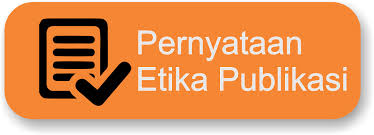Relasi Manusia Dan Pengada Dalam Konsep Kalepasan Tutur Brahmokta Widhisastra
DOI:
https://doi.org/10.37329/jpah.v7i3.2398Keywords:
Human Relations, Kalepasan, Tutur Brahmokta WidhisastraAbstract
Hindus believe in union with Brahman as the ultimate goal of life, the source of all life. The Balinese have always infused these ideas into knowledge that is considered confidential. Because readers struggle to understand and those who put it into practice require the presence of a near-perfectly competent teacher. Lack of attention to traditional Balinese texts containing metaphysical ideas and knowledge of perfection is the background of this study. This study is an attempt to describe the relationship between humans and beings from a metaphysical point of view in the form of a traditional text, the Tutur Brahmokta Widhisastra. The Tutur Brahmokta Widhisastra is one of his Siwaist-style texts that strongly expresses Kalepasan idea as one of the concepts of the relationship between humans and beings. The qualitative approach used in this study focuses on a philosophical approach that uses hermeneutic research methods to reveal the metaphysical ideas contained in Tutur Brahmokta Widisastra. Based on the critical analysis carried out, the relationship between humans and beings in Tutur Brahmokta Widisastra, the relationship between humans and beings in the human body and organs, becomes the stana of the gods and as the immovable mover of Shivaism. Kalepasan as a concept of union requires the performer to be able to understand the positions of the organs of the human body as the Sthana of the gods. In addition, people also need to understand the urips and scriptures (aksara) that represent each organ, each god. After full understanding and practice become possible, people will undoubtedly connect with beings through the path of pranayama and yoga.
References
Ciptoprawiro, A. (1986). Filsafat Jawa. Jakarta: Balai Pustaka.
Kattsoff, L. (2004). Pengantar Filsafat. Yogyakarta: Kanisius.
Kobalen, & B.Sc, S. K. (2010). Proses Kremasi & Esensi Perjalanan Atma Menuju Moksa. Surabaya: Paramita.
Koentjaraningrat. (2002). Pengantar Antropologi. Bandung: Rineka Cipta.
Mahfud. (2015). Tuhan Dalam Kepercayaan Manusia Modern (Mengungkap Relasi Primordial Antara Tuhan dan Manusia). Cendekia: Jurnal Keislaman, 1(2).
Mantik, A. S. (2007). Bhagavadgita. Surabaya: Paramita.
Mukhtasar, M. (2000). Teologi Pembebasan Menurut Asghar Ali Engineer: Makna dan relevansinya dalam Konteks Pluralitas Agama di Asia. Jurnal Filsafat, 31(258–269).
Nala, N. (2006). Aksara Suci Dalam USada. Surabaya: Paramita.
Ngabalin, M. (2017). Teologi Pembebasan Menurut Gustavo Gutierrez Dan Implikasinya Bagi Persoalan Kemiskinan. Kenosis: Jurnal Kajian Teologi, 3(2).
Pradnya, I. M. A. S. (2010). Persepsi Masyarakat Hindu Terhadap Ilmu Leak Di Desa Pekraman Muncan, Selat, Karangasem. Denpasar: Institut Hindu Dharma Negeri Denpasar.
Saraswati, I. A. G. A., & Paramita, I. G. A. (2017). Konsep Surga, Neraka Dan Moksa Dalam Kakawin Candra Bairawa. Dharma Smrti, 15(28).
Sudani, N. K. (2017). Pemahaman Konsep Tattwadengan Ketrampilan Upakara Bhuta Yadnya Pembelajaran Kooperatif Siswa Klas VIIIA SMP PGRI Gianyar 4 di Bakbakan, Tahun 2013/2014. Dharma Smrti, XVII(2), 80–85.
Surpi, N. K., Avalokitesvari, N. N. A. N., Untara, I. M. G. S., & Sudarsana, I. K. (2021). Interpretation of Symbols, Veneration and Divine Attributes in Dieng Temple Complex, Central Java. Space And Culture, India, 8(4).
Suwantana, I. G. (2021). Sakti Yoga Saivagama Nusantara. Denpasar: Nilacakra.
Tim Penyusun. (2001). Alih Aksara Tutur Brahmokta Widhisastra. Denpasar: Dinas Kebudayaan Provinsi Bali.
Titib, I. M. (2003). Teologi dan Simbol-Simbol dalam Agama Hindu. Surabaya: Paramita.
Titib, I. M. (2006). Persepsi Umat Hindu di Bali Terhadap Svarga, Neraka, Moksa Dalam Svargarohanaparva. Surabaya: Paramita.
Yendra, I. W. (2009). Kanda Empat Dewa. Surabaya: Paramita.
Yogiswari, K. S. (2018). Tinjauan Metafisika Anton Bakker dalam Prinsip Hidup Orang Jawa Kawruh Begja. Jurnal Filsafat Indonesia, 1(3).
Yogiswari, K. S. (2019). Keraguan Kritis Descartes. Sanjiwani Jurnal Filsafat, 10(1).
Yogiswari, K. S. (2020). The Relevance of Hindu God Concept And Argumeny Proving The Exixtence of God Perspektive Gottfried Wilhelm Leibniz. Vidyottama Sanatana: International Journal of Hindu Science and Religious Studies, 4(2).
Yogiswari, K. S. (2021). Konsep Ketuhanan dalam Filsafat Erich Fromm (1900-1980). Sanjiwani Jurnal Filsafat, 12(1).
Yudhiantara, K. (2003). Dasaksara Saiwa Siddhanta Dan Kanda Pat. Surabaya: Paramita.
Zoetmulder, P. J. (1991). Manunggaling Kawula Gusti : pantheisme dan monisme dalam sastra suluk Jawa. Jakarta: Gramedia Pustaka Utama.
Downloads
Published
How to Cite
Issue
Section
License
Copyright (c) 2023 Ida Bagus Wika Krishna, Krisna S. Yogiswari

This work is licensed under a Creative Commons Attribution-ShareAlike 4.0 International License.
An author who publishes in the Jurnal Penelitian Agama Hindu agrees to the following terms:
- Author retains the copyright and grants the journal the right of first publication of the work simultaneously licensed under the Creative Commons Attribution-ShareAlike 4.0 License that allows others to share the work with an acknowledgement of the work's authorship and initial publication in this journal
- Author is able to enter into separate, additional contractual arrangements for the non-exclusive distribution of the journal's published version of the work (e.g., post it to an institutional repository or publish it in a book) with the acknowledgement of its initial publication in this journal.
- Author is permitted and encouraged to post his/her work online (e.g., in institutional repositories or on their website) prior to and during the submission process, as it can lead to productive exchanges, as well as earlier and greater citation of the published work (See The Effect of Open Access).
Read more about the Creative Commons Attribution-ShareAlike 4.0 Licence here: https://creativecommons.org/licenses/by-sa/4.0/.








